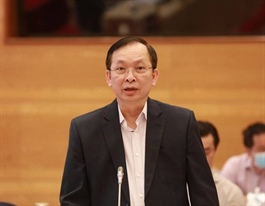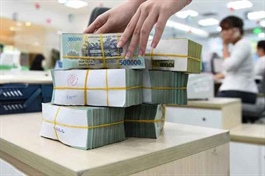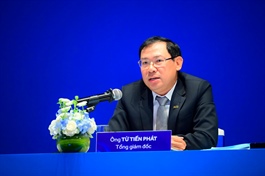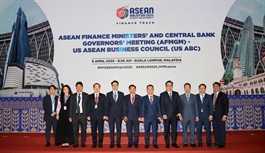Monetary policy space narrows as trade uncertainty weighs on FX market
Monetary policy space narrows as trade uncertainty weighs on FX market
Earlier this morning (April 10, Vietnam time), the United States announced a 90-day suspension and a reduction of reciprocal tariffs to 10 per cent to over 75 trading partners, including Vietnam. The tariff policy, however, still leaves room for uncertainties regarding the final policy direction, casting pressure on Vietnam’s foreign exchange market.
Speaking with VIR, Nguyen Ba Hung, chief economist at Asian Development Bank (ADB) in Vietnam, noted that ASEAN and East Asian currencies have remained mostly stable, except for short-term fluctuations in a few economies. The VND has also reacted modestly to the US policy shift.

The US is a major market for Vietnam’s textile apparel export, so impact from the new tariff policy will be significant |
On April 3, following the announcement of US administration’s tariff policy, the State Bank of Vietnam (SBV) set the central exchange rate at VND24,854 per USD, a slight increase of VND03 compared to the previous session. The next day, on April 4, the SBV raised the central rate to VND24,886, up by VND32 from the April 3 closing rate.
From the outset of the year to April 8, the VND had depreciated by 1.79 per cent.
“Basically, the VND has remained stable, and the State Bank of Vietnam (SBV) has managed monetary and exchange rate policies very effectively throughout 2024,” Hung said. However, he emphasised that it is still too early to make definitive forecasts.
“There will inevitably be sensitive periods causing short-term forex market volatility,” Hung added. “But current data shows ASEAN and East Asia have solid monetary policy foundations to support exchange rate stability.”
Shantanu Chakraborty, ADB’s country director in Vietnam, praised the SBV’s policy approach, highlighting that although inflation has slightly risen, it remains under 4 per cent.
“The SBV still has tools at its disposal,” he said. “If inflationary pressure builds, the central bank could slightly raise interest rates and manage the exchange rate to maintain home currency stability.”
He acknowledged the interplay between interest rate and exchange rate, but expressed confidence, “We believe SBV will continue to apply supportive and appropriate monetary policies to stabilise the forex market.”
Several analysts agree that the VND had already been gradually depreciating in the recent months, so short-term exchange rate pressure may not be too severe. While there may be fluctuations in the short term, the overall trend is expected to remain relatively stable.
Dinh Quang Hinh, head of Macroeconomics and Market Strategy at Hanoi-based VNDIRECT Securities said, “The US has announced a 90-day suspension of reciprocal tariffs on over 75 countries, except China, and lowered rates to 10 per cent, effective immediately. Still, the policy remains uncertain, with unpredictable shifts ahead. If tariffs are reinstated after the grace period, it would significantly impact Vietnam’s foreign currency inflows and forex market.”
Hinh warned that Vietnam’s exports to the US could decline, affecting trade surpluses and foreign exchange reserves. FDI could also slow, especially among firms targeting the US market via Vietnam.
He also cautioned about indirect risks. “If US-China tensions escalate, the Chinese yuan could weaken substantially, putting pressure on the VND. China is Vietnam’s largest trading partner, and Vietnam runs a large trade deficit with China,” he said.
Overall, Hinh said the US tariff policy could drive further VND depreciation and challenge the SBV’s easing stance.
“While the SBV aims to lower interest rates to support growth, rising exchange rate risks could significantly narrow the room for further monetary easing,” he said.
In a related development, the ASEAN+3 Macroeconomic Research Office (AMRO) stated that the newly announced US reciprocal tariffs may pose a severe trade shock to the ASEAN+3 region, including Vietnam.
The tariffs have already triggered stock market declines and capital flows shifting from equities into bonds and safe-haven currencies.
According to AMRO, the impact of the tariff measures will vary among countries in the region, depending on how each adjusts its policy responses.
Economic growth in ASEAN+3 is forecast to slow down if trade tensions persist. However, AMRO also noted that the region has gradually reduced its reliance on exports to the US by enhancing intra-regional trade and expanding into the Chinese market, thereby increasing resilience to external shocks.
“Policy responses across countries should be targeted and flexible. In addition to prudent coordination between monetary and fiscal policy to ensure financial stability, encouraging trade and services liberalisation, export diversification, and enhancing innovation capacity will help improve competitiveness and bolster the region’s medium- and long-term resilience,” AMRO said.
- 08:00 12/04/2025


























